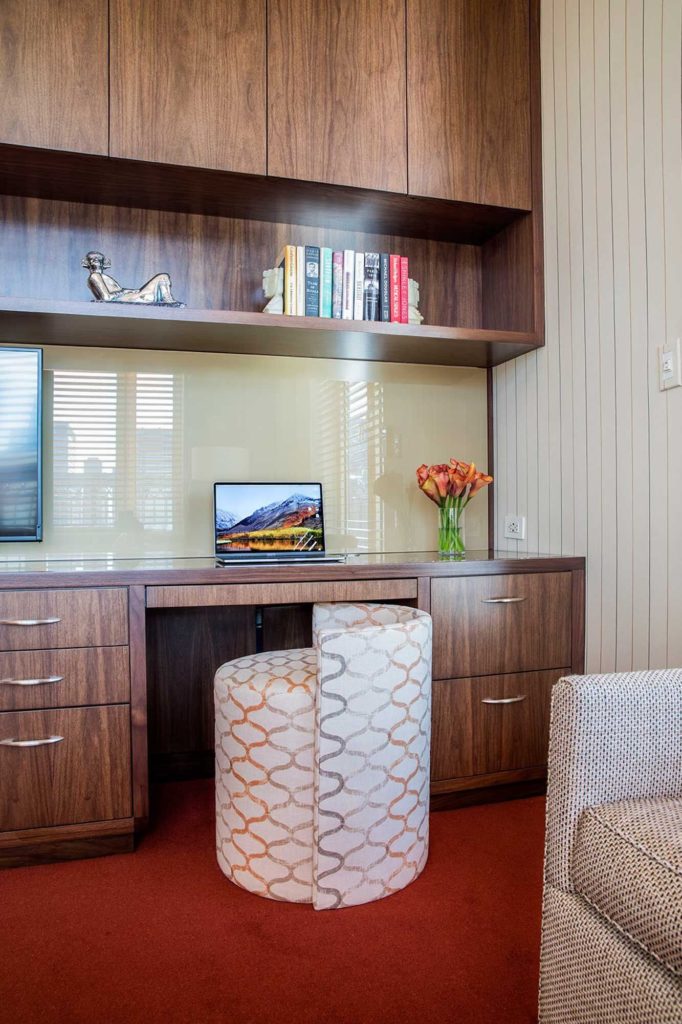So much of what I do as a designer is get to know my clients and understand their habits, both the ones they want to keep and the ones they want to change.

There is a concept I apply in my life known as the “only touch it once” rule. Examples of this are placing dishes in the sink, and then later moving them to the dishwasher, or throwing laundry on the floor, and then later moving it to a hamper — two steps instead of one. If you find yourself at the end of the day with a lot to tidy up, you may be creating work for yourself by needlessly doing tasks in phases. But it may also be that your space is not working for you. Make things easy by giving everything you need a proper home in easy reach of where it is used. Plan your design for your habits.

Start with a purge
You can probably see that you will want to do inventory and shed some of your redundant items. If you have five staplers and several containers of pens, you can give away, donate, or recycle to reduce volume. In fact, if you have any two tools that are doing the exact same job, get rid of one. It doesn’t make sense to use up space storing two tools that do the same thing.
Let the most important items take center stage (what you need AND what you love). And consider this: your most important items will be crowded from your field of view by all the redundancies in your environment. Leave only what matters, so that you can design for your best use.
From self analysis to design solutions
Practical considerations will inform the basic structure of your design. You’ll need your primary tools of course — computer, shelving, work station, reference library, task lighting, white board, drafting or design areas, and so on. But this list shouldn’t just be a series of items. What will really help is to identify problems in need of solutions. What are your recurring issues? Does your office chair become uncomfortable after a while? Do you have what you need when you need it? Are those things in arm’s reach? Does every item have a home? Are there currently things that don’t have to be there?
And of course, you should think about the look of this space. What colors, shapes, light, scents and so on comprise your most perfect work environment? Colored light can stimulate higher brain function, for example, so consider automated lighting or colored LED to bolster your productivity.
Create a space that inspires you to succeed
Whatever helps you be in the best place physically, mentally and emotionally can and should be considered a top priority. Do an image search for examples of your ideas to help you refine your preferences. Save the best ones to use when you diagram your space. You want to encourage your best self to show up for work each day. You want your environment to inspire and support you. Work is such a big part of life, so let it be pleasurable. You deserve it.
RELATED POSTS
As an Amazon Associate, this site may contains affiliate links and I can earn from qualifying purchases at no cost to you. View disclosure for more information.
I'm Claudia. Welcome to my Interior Design blog! I'm thrilled to share my expertise and passion with you. With over 20 years in the industry, I'm a Certified Interior Designer, holding an NCIDQ Certification, and an educator. Interior Design isn't just my career—it's my passion. Dive in to explore more about me. Click here to learn more!
Hi Friend!
Stay inspired—join our design community by subscribing to the blog today.
subscribe now
Other Posts You Might Like
©2025 Claudia Giselle Design | Interior Designer | Brooklyn, New York
Legal
BACK TO TOP
Testimonials
718-255-5949
Press
office@claudiagiselle.com
MENU
We create thoughtful, personalized interiors for those who value quality and beauty in every detail — serving NYC, Manhattan, Brooklyn, Long Island, the Hamptons, and the Hudson Valley (including Westchester and Dutchess County) & Beyond.
Timeless Classicism with a
Bold Touch of Elegance
Home
Services
Process
About
Blog
Portfolio
Scheudule a Consultation
GET IN TOUCH
Contact





